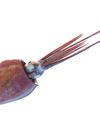
LIFE AT THE DEEPEST DEPTHS
The world's oceans are some of the most hostile environments to live in. From freezing polar waters to the darkness of the oxygen-depleted abyssal zone, life has adapted to the many different challenges that the ocean has to offer. Deep-sea creatures quite literally have to bear the weight of the world's water on their proverbial shoulders. To avoid being crushed by their highpressure environment, many deepsea species have evolved bodies made up mainly of water and utilise molecules called piezolytes to counteract the weight of the surrounding water. For example, more than 8,000 metres below the ocean surface off the coast of Japan, scientists have found what is potentially the deepest-dwelling fish in the world, the Mariana snailfish. The snailfish's piezolytes increase the space that proteins take up in a cell and prevent water from pushing its way inside.
Arguably the most hostile environments for life underwater can be found 2,500 metres below the ocean's surface, where hydrothermal vents called black smokers are found. These holes in the seafloor are where magma and water meet. Temperatures up to around 300 degrees Celsius and toxic gas emissions are just some of the hurdles that many animals have to overcome to call these vents home.
LIFE AT THE VENTS
Some of the animals that call these toxic underwater chimneys home
1 YETI CRAB
Discovered in 2005, these hairy-clawed crustaceans spend their time scurrying around hydrothermal vents, particularly in the Pacific-Antarctic Ridge, which lies south of Easter Island. Unlike their crabby cousins nearer the surface, yeti crabs use their hairs, called setae, to collect their main food source: bacteria. These crabs also wave their claws around to move the flow of water and minerals that help bacteria reproduce.
2 POMPEII WORM
Esta historia es de la edición Issue 192 de How It Works UK.
Comience su prueba gratuita de Magzter GOLD de 7 días para acceder a miles de historias premium seleccionadas y a más de 9,000 revistas y periódicos.
Ya eres suscriptor ? Conectar
Esta historia es de la edición Issue 192 de How It Works UK.
Comience su prueba gratuita de Magzter GOLD de 7 días para acceder a miles de historias premium seleccionadas y a más de 9,000 revistas y periódicos.
Ya eres suscriptor? Conectar

INCREDIBLE SOLAR SYSTEM CRATERS
Why these spectacular craters carved out by past impact events are among the most widespread and distinctive geological features in the Solar System

HOW NORTH AMERICA'S GREAT LAKES FORMED
The world's largest freshwater system comprises five immense interconnected lakes, carved into Earth by glaciers

BUILDING THE WORLD'S DEEPEST CAR PARK
Australia's most famous landmark is often marvelled at from ground level, but its innovative spiral substructure is a hidden gem

FINDING THE COLOSSAL SQUID
This elusive creature spawned a legend of a deep-sea monster that endured for centuries

Octopuses burn more calories changing colour than you do on a 23 minute run
For octopuses, changing colour burns about as many calories as a human on a 23-minute run. Octopuses are masters of disguise, changing colour at the drop of a hat to startle predators and hide from prey.
The world's first silicon-anode battery could revolutionise electronic vehicles
A ceramic battery manufacturer has unveiled a solid-state battery concept that can be charged from 5 to 60 per cent capacity in just five minutes, giving future electric vehicles (EVS) a 186-mile range in the time it takes to order a coffee.

New technology gives AI the power to feel surfaces
Scientists have given artificial intelligence (AI) the capacity to 'feel' surfaces for the first time, opening up a new dimension for deploying the technology in the real world.

Visit Plane Earth 2125
How might our world have transformed under the strain of climate change 100 years from now?

The world's largest organism may have been growing for 80,000 years
Pando, an enormous quaking aspen that spans more than 40 hectares in Utah, is not only one of the largest known organisms on Earth, it's also one of the oldest.

Scientists detect the most powerful cosmic rays ever
Scientists have detected the most energetic cosmic rays ever discovered, and they're being produced by mysterious sources relatively close to Earth.